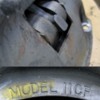The only thing that changes here is the long throw slave cylinder. Apparently with it you CAN use a Mustang DIAPHRAGM clutch. That's a good thing, but it will only fix the travel issue, not the clearance issue of the wrong Long clutch not clearing the ZF bellhouse.
With the standard slave everything stated about needing a Pantera clutch is accurate.
Personally I'll be buying one ASAP. Does Pantera East have an on line presence and catalog?
Thanks for sharing your experiences Scott, that helps.
Incidentally my Centerforce Pantera clutch does have the counterweights and I haven't experienced any issue with them as of yet.
My understanding of how they work is that at idle they are doing nothing but as rpms rise and the centrifugal force moves them outward, they apply more clamping force to the clutch fingers?
I've never seen a graph or data sheet on this effect from anyone but I'm sure there is one around somewhere on the net?
The only number I heard about the Centerforce is that "the racers", and they know who they are, say the clutch is good for around 800 hp.
One thing that I did notice with the Centerforce is that around 6000rpm the pedal gets very hard. In my GT350 it will push the pedal up. The Pantera I haven't noticed that most likely because of the hydraulics.
As far as what Bosswrench is saying about the original Pantera clutch having no counter weights, I agree with him. I think he was refering to the Long style and not the Centerforce diaphragm type though.
He is referring to the little "dumbells" on the short end of the three arms on the clutch cover. They wouldn't clear the inside of the ZF aluminum bellhousing, using a normal Mustang clutch cover (pressure plate) or any other Ford Long clutch for that matter.
The Pantera long clutch doesn't have them. It uses different lever arms.
If you attempt to use the "long" clutch from a Mustang, unless the bellhouse has been clearance internally for them, there is going to be some serious internal collisions, with a lot of disgusting internal noise, followed by a lot of crying over broken parts.
Using a long throw slave cylinder won't save you on that.
But this only pertains to Long clutch, not the Centerforce diaphram type.
There are always people that complain that they are new and need information. When the experienced "old" guys give it to them, then they turn and complain that the old guys don't know what they are talking about. Ironic isn't it.
In my case I have always tried to listen to them. I learned that they are not necessarily highly intelligent, just highly experienced. Your mileage may vary.
Cavete emptor.



